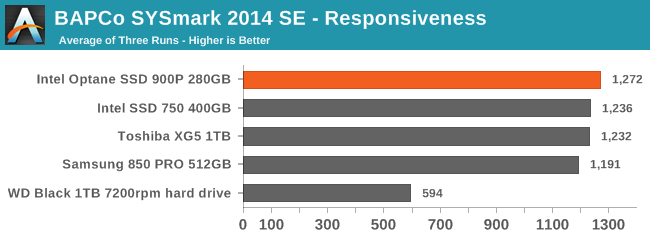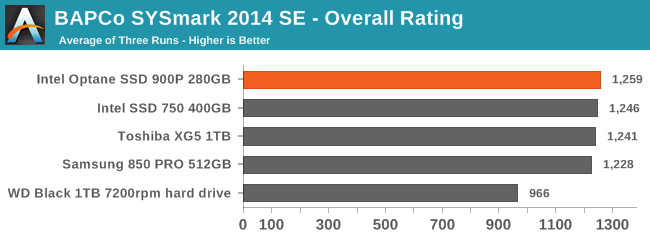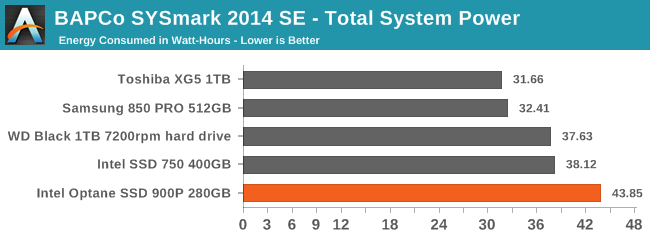The Intel Optane SSD 900P 280GB Review
by Billy Tallis on October 27, 2017 9:30 AM ESTBAPCo SYSmark 2014 SE
BAPCo's SYSmark 2014 SE is an application-based benchmark that uses real-world applications to replay usage patterns of business users in the areas of office productivity, media creation and data/financial analysis. In addition, it also addresses the responsiveness aspect which deals with user experience as related to application and file launches, multi-tasking etc. Scores are calibrated against a reference system that is defined to score 1000 in each of the scenarios. A score of, say, 2000, would imply that the system under test is twice as fast as the reference system.
SYSmark scores are based on total application response time as seen by the user, including not only storage latency but time spent by the processor. This means there's a limit to how much a storage improvement could possibly increase scores, because the SSD is only in use for a small fraction of the total test duration. This is a significant difference from our ATSB tests where only the storage portion of the workload is replicated and disk idle times are cut short to a maximum of 25ms.
| AnandTech SYSmark SSD Testbed | |
| CPU | Intel Core i5-7400 |
| Motherboard | ASUS B250-PLUS |
| Chipset | Intel B250 |
| Memory | 2x 8GB Kingston DDR4-2400 CL17 |
| Case | In Win C583 |
| Power Supply | Cooler Master G550M |
| OS | Windows 10 64-bit, version 1703 |
Our SSD testing with SYSmark uses a different test system than the rest of our SSD tests. This machine is set up to measure total system power consumption rather than just the drive's power.


SYSmark 2014 SE doesn't come close to stressing the storage system enough to show meaningful distinctions between high-end NVMe SSDs. The Responsiveness sub-test is the most sensitive to storage performance, and only shows a few percent difference between most SSDs. The overall test barely registers a difference at all. But with my primary power meter broken, SYSmark does provide a rough assessment of how power hungry the Intel Optane SSD 900P is:

The SYSmark energy usage scores measure total system power consumption, excluding the display. Our SYSmark test system idles at around 26 W and peaks at over 60 W measured at the wall during the benchmark run. SATA SSDs seldom exceed 5 W and idle at a fraction of a watt, and the SSDs spend most of the test idle.
Despite being the fastest drive in this bunch and thus the one with the shortest SYSmark run times, the Optane SSD 900P used far more energy over the course of the three SYSmark runs. With higher idle power than even the Intel SSD 750 and similar power draw under load, the Optane SSD 900P really needs its heatsink. Intel is a very long way off from being able to package this level of performance in a M.2 SSD.










205 Comments
View All Comments
investlite - Monday, November 6, 2017 - link
I bet you're still pissed we don't have flying cars. OMG, do you go to every new car unveiling and talk about how crappy each new car is because we were supposed to have flying cars by now?Gothmoth - Friday, October 27, 2017 - link
when you do huge particle simulations you will want the fastest SSD you can get.ddriver - Friday, October 27, 2017 - link
I've been doing that, for VFX as well as multiphysics simulations for over a decade. It has always been an in-memory thing. It doesn't seem they simulated it, it seems they read baked simulation data, and stored in some insanely inefficient manner at that.As I implied, this has got to be a new record in rigged benchmarks. Shame!
extide - Friday, October 27, 2017 - link
Sigh, the Optane drive didn't improve the performance of reading the data into the simulation. The simulation required (significantly?) more RAM than the system had. They put a big swap file on either a 960 PRO or on the Optane drive. It probably doesn't even matter where the simulation data was stored.ddriver - Friday, October 27, 2017 - link
Well, they should have bought moar ram then. Then maybe they could have kept that CPU busy at 100% and get much better time.I mean it is not like hypetane offers terabytes of capacity. Topping at 480 GB - that's entirely doable in RAM. More expressive - sure, but nonetheless a perfectly sensible investment if you are doing such simulations. It will pay for itself, as RAM is tremendously faster, and also doesn't wear, at least nowhere nearly as much as xpoint does.
extide - Friday, October 27, 2017 - link
For that particular case, sure, maybe more ram is the way to go, but there are plenty of cases where the drive is better, like several of the ones I mentioned above. Most of those rely on the non-volatile aspect, which obviously RAM doesn't have.ddriver - Friday, October 27, 2017 - link
As I said - it has its advantages and uses. I also said I might even buy it.And the only reason I call it hypetane is because intel shamelessly lied about it, and continues to cheat in order to make it look good even after it became evident that it is not anywhere nearly as good as they initially claimed, and call me old-fashioned, but I have a problem with that.
It boggles the mind that people around here have such a problem with me just because I don't have my tongue up intel's rectum...
ddriver - Friday, October 27, 2017 - link
BTW, 1.1 billion particles, presuming the simulation is ran in FP64 mode, with x y and z coordinates for each particle would only require about 24 gigs of ram.Which raises the question, did they allocate each of those points on the heap or something?
ddriver - Friday, October 27, 2017 - link
Opsie, silly me, it would take another 24gb for the vector of force for each particle. Now it is a little more plausible that 64gb might not be enough.CaedenV - Sunday, October 29, 2017 - link
Sure, in a perfect world you buy more RAM. But if you are in a situation where you don't have infinate cash and you can buy more RAM at $7/GB or an Optane SSD for ~$1-2/GB then Optane begins to look a bit more appealing. A 480GB drive running as cache for $600 vs 480GB of DDR4 at $3350.... that would make almost anyone thing twice.Or in the case of my work, we have a bunch of clustered servers, and we are maxxed out on ram but not yet ready to do a server upgrade (hoping to get 2 more years out of them), but we need more fast cache for a bunch of different applicaitons. The idea of running those caches on this kind of SSD sounds a lot more appealing than running on traditional SSDs.
But yes, when we upgrade servers, we will simply have more RAM on board. That is the obvious solution. But when a motherboard can only hold 256GB of RAM and you need more... life is often about compromises, and Optane tech sounds like a good compromise. But what you would use this for in daily life or in a normal computer? Man, that totally beats me! This product is almost too cheap for what it is good for (business class SSDs typically cost more than $1.25/GB still and are far slower than consumer SSDs), and completely useless and overpriced for that they are advertising it for.